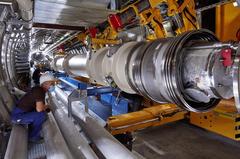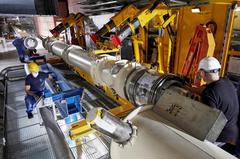URL: https://www.desy.de/news/news_search/index_eng.html
Breadcrumb Navigation
DESY News: All ALPS magnets installed in the tunnel
News
News from the DESY research centre
All ALPS magnets installed in the tunnel
DESY's "light through the wall experiment" ALPS II is taking shape. ALPS, short for "Any Light Particle Search", is being installed in a tunnel section of the former HERA accelerator. The international ALPS team will search for dark matter using twenty-four former HERA magnets, laser light and a highly sensitive detector. The last of these superconducting magnets was installed last week. During the last weeks all superconducting magnets have been brought into the tunnel. The last big part for connecting the magnets was installed today.

Installation of one of the last superconducting magnets. Image: DESY / Heiner Müller-Elsner
Hopefully, ALPS II will be able to eliminate another “that can't be done” once it is in operation. So far, no experiment in the world has been able to detect dark matter. Researchers use telescopes, particle accelerators and even huge underground tanks to search for it, and its discovery would be a sensation, because in one fell swoop we would know six times more about our universe than we do now.
The nature of dark matter is one of the greatest mysteries of physics. Observations and calculations of the movement of stars in galaxies show that there must be more matter in the universe than we can explain with the particles of matter we know today. In fact, dark matter should account for 85% of all matter in the universe. However, we currently do not know what the components of dark matter are. But we do know that it virtually does not interact with normal matter and is essentially invisible, hence the term "dark".
There are many theories that try to explain the nature of dark matter and the particles of which it could be composed. Some of these theories say that dark matter is made up of very light particles with very specific properties, for example the axion. It was originally postulated to explain aspects of the strong interaction, one of the fundamental forces of nature. ALPS was specifically designed to create and detect these particles. A strong magnetic field can cause axions to transform into particles of light, photons, and vice versa.

It's between these last two magnets where light is supposed to shine through the wall when ALPS II goes into operation. Image: DESY / Heiner Müller-Elsner
The next steps for ALPS II are the precise alignment of the magnets and the completion of three clean rooms in which the complex and highly sensitive optics will be set up. "We hope to be able to begin the search for dark matter in a year's time," says Guido Müller, Professor at the University of Florida, Gainesville, and deputy spokesman for the ALPS collaboration.



